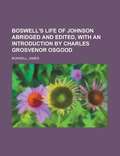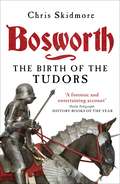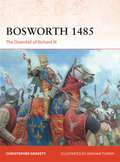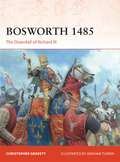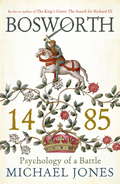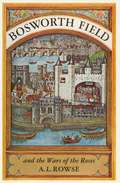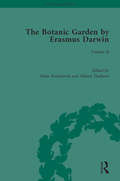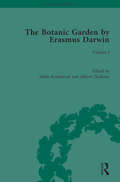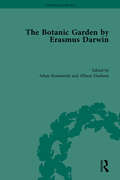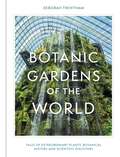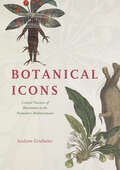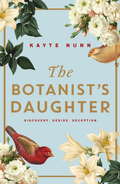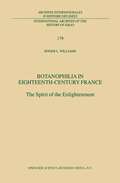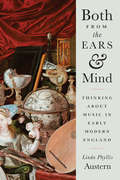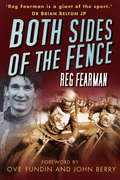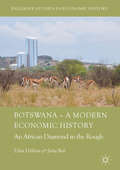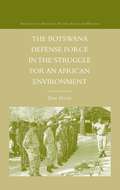- Table View
- List View
Boswell's Life of Johnson
by James BoswellIn Boswell's Life of Samuel Johnson, one of the towering figures of English literature is revealed with unparalleled immediacy and originality, in a biography to which we owe much of our knowledge of the man himself. Through a series of richly detailed anecdotes, Johnson emerges as a sociable figure, vigorously engaging and fencing with great contemporaries such as Garrick, Goldsmith, Burney and Burke, and of course with Boswell himself. Yet anxieties and obsessions also darkened Johnson's private hours, and Boswell's attentiveness to every facet of Johnson's character makes this biography as moving as it is entertaining. In this entirely new and unabridged edition, David Womersley's introduction examines the motives behind Boswell's work, and the differences between the two men that drew them to each other. It also contains chronologies of Boswell and Johnson, appendices and comprehensive indexes, including biographical details. For more than seventy years, Penguin has been the leading publisher of classic literature in the English-speaking world. With more than 1,700 titles, Penguin Classics represents a global bookshelf of the best works throughout history and across genres and disciplines. Readers trust the series to provide authoritative texts enhanced by introductions and notes by distinguished scholars and contemporary authors, as well as up-to-date translations by award-winning translators.
Bosworth: The Birth of the Tudors
by Chris SkidmoreRichard III and Henry Tudor's legendary battle: one that changed the course of English history.On the morning of 22 August 1485, in fields several miles from Bosworth, two armies faced each other, ready for battle. The might of Richard III's army was pitted against the inferior forces of the upstart pretender to the crown, Henry Tudor, a 28-year-old Welshman who had just arrived back on British soil after 14 years in exile. Yet this was to be a fight to the death - only one man could survive; only one could claim the throne.It would become one of the most legendary battles in English history: the only successful invasion since Hastings, it was the last time a king died on the battlefield. But BOSWORTH is much more than the account of the dramatic events of that fateful day in August. It is a tale of brutal feuds and deadly civil wars, and the remarkable rise of the Tudor family from obscure Welsh gentry to the throne of England - a story that began 60 years earlier with Owen Tudor's affair with Henry V's widow, Katherine of Valois.Drawing on eyewitness reports, newly discovered manuscripts and the latest archaeological evidence, Chris Skidmore vividly recreates this battle-scarred world in an epic saga of treachery and ruthlessness, death and deception and the birth of the Tudor dynasty.
Bosworth 1485: The Downfall of Richard III (Campaign)
by Christopher GravettThe battle of Bosworth was the culmination of the War of the Roses, the dynastic struggle between the houses of York and Lancaster that dominated England in the second half of the 15th century. Edward IV had secured the throne for the house of York, but his early death in 1483, followed by the death of his sons and the taking of the throne by his brother, Richard of York, saw a renewed outbreak of fighting. His reign began with a major rebellion and was dogged by rumours of his involvement in murder, with Richard facing threats not only from the lords he alienated but also the Lancastrian faction waiting in the wings. Henry Tudor eventually decided to take the huge risk of attempting to seize the throne and Richard's army marched to meet him, finally clashing near Market Bosworth. Guiding the reader from the campaign's origins to its aftermath, and covering the commanders and forces of King Richard III and Henry Tudor, this is a complete treatment of one of the most important events in English history. The story of Bosworth has been transformed in the 20th century as an extensive survey between 2005 and 2009 by the Battlefields Trust has pinpointed the location of the battlefield, for many years a source of debate and controversy, and this new history is based on that interpretation. It will also highlight the incredible discovery of Richard III's remains in Leicester, the study of the bones and relate this to what was previously thought to have happened to him at the end of the battle.
Bosworth 1485: The Downfall of Richard III (Campaign #360)
by Christopher GravettThe battle of Bosworth was the culmination of the War of the Roses, the dynastic struggle between the houses of York and Lancaster that dominated England in the second half of the 15th century. Edward IV had secured the throne for the house of York, but his early death in 1483, followed by the death of his sons and the taking of the throne by his brother, Richard of York, saw a renewed outbreak of fighting. His reign began with a major rebellion and was dogged by rumours of his involvement in murder, with Richard facing threats not only from the lords he alienated but also the Lancastrian faction waiting in the wings. Henry Tudor eventually decided to take the huge risk of attempting to seize the throne and Richard's army marched to meet him, finally clashing near Market Bosworth. Guiding the reader from the campaign's origins to its aftermath, and covering the commanders and forces of King Richard III and Henry Tudor, this is a complete treatment of one of the most important events in English history. The story of Bosworth has been transformed in the 20th century as an extensive survey between 2005 and 2009 by the Battlefields Trust has pinpointed the location of the battlefield, for many years a source of debate and controversy, and this new history is based on that interpretation. It will also highlight the incredible discovery of Richard III's remains in Leicester, the study of the bones and relate this to what was previously thought to have happened to him at the end of the battle.
Bosworth 1485: Psychology of a Battle (Battles And Campaigns Ser.)
by Michael JonesIn 1485 the Battle of Bosworth marked an epoch in the lives of two great houses: the house of York fell to the ground when Richard III died on the field of battle; and the house of Tudor rose from the massacre to reign for the next hundred years. Michael Jones co-author of The King's Grave: The Search for Richard III rewrites this landmark event in English history. He shifts our perspective of its heroes and villains and puts Richard firmly back into the context of his family and his times.
The Botanic Garden by Erasmus Darwin: Volume II (The Pickering Masters)
by Adam KomisarukThe career of Erasmus Darwin (1731-1802) affords an extraordinary glimpse into the intellectual ferment of late-eighteenth- and early-nineteenth-century Britain. As a popular poet, practicing physician, inventor of speaking machines and mechanical birds, essayer of natural history from geology to meteorology, and proponent of an evolutionary theory that inspired his famous grandson Charles, he left a lasting impression on almost every branch of knowledge. His magnum opus, and the synthesis of his myriad interests, is The Botanic Garden (1792) — an epic poem that aims to "enlist the Imagination under the banner of Science." Part I, The Economy of Vegetation, sings the praises of British industry as a dance of supernatural creatures while part II, The Loves of the Plants, wittily employs metaphors of human courtship to describe the reproductive cycles of hundreds of flowers. Darwin supplements his accomplished verses with (often much longer) "philosophical notes" that offer his idiosyncratic perspective on the scholarly controversies of the day. Despite a recent surge of academic interest in Darwin, however, no authoritative critical edition of The Botanic Garden exists, presenting a barrier to further scholarship. This two volume set comprises a complete, meticulously transcribed, reading text — including all the poetry, prose apparatus, and illustrations — along with extensive commentary that situates Darwin within contemporary debates about the natural sciences. This set will be of interest to readers as the definitive reference edition of The Botanic Garden and due to its efforts to make the work more practically and intellectually accessible to seasoned and novice readers alike This second volume includes the full version of the second part of The Botanic Garden, The Lives of Plants along with the related textual apparatus consisting of the editors’ annotations, discussion of the illustrations, textual notes, and a taxonomic table of the flowers mentioned.
The Botanic Garden by Erasmus Darwin: Volume I (The Pickering Masters)
by Adam KomisarukThe career of Erasmus Darwin (1731-1802) affords an extraordinary glimpse into the intellectual ferment of late-eighteenth- and early-nineteenth-century Britain. As a popular poet, practicing physician, inventor of speaking machines and mechanical birds, essayer of natural history from geology to meteorology, and proponent of an evolutionary theory that inspired his famous grandson Charles, he left a lasting impression on almost every branch of knowledge. His magnum opus, and the synthesis of his myriad interests, is The Botanic Garden (1792) — an epic poem that aims to "enlist the Imagination under the banner of Science." Part I, The Economy of Vegetation, sings the praises of British industry as a dance of supernatural creatures while part II, The Loves of the Plants, wittily employs metaphors of human courtship to describe the reproductive cycles of hundreds of flowers. Darwin supplements his accomplished verses with (often much longer) "philosophical notes" that offer his idiosyncratic perspective on the scholarly controversies of the day. Despite a recent surge of academic interest in Darwin, however, no authoritative critical edition of The Botanic Garden exists, presenting a barrier to further scholarship. This two volume set comprises a complete, meticulously transcribed, reading text — including all the poetry, prose apparatus, and illustrations — along with extensive commentary that situates Darwin within contemporary debates about the natural sciences. This set will be of interest to readers as the definitive reference edition of The Botanic Garden and due to its efforts to make the work more practically and intellectually accessible to seasoned and novice readers alike. The first volume presents a wide ranging and authoritative introduction to The Botanic Garden, detailing the background to the work and the various contexts in which it should be understood. These include: aesthetic theory and practice, the science of the mind, love and sexuality, politics, spirituality, the natural sciences, and evolutionary theory and the two Darwins. The full text of Part I of the The Botanic Garden, The Economy of Vegetation, then follows accompanied by the editors’ annotations, discussion of illustrations and textual notes.
The Botanic Garden by Erasmus Darwin: Volume I (The Pickering Masters)
by Adam KomisarukThe career of Erasmus Darwin (1731-1802) affords an extraordinary glimpse into the intellectual ferment of late-eighteenth- and early-nineteenth-century Britain. As a popular poet, practicing physician, inventor of speaking machines and mechanical birds, essayer of natural history from geology to meteorology, and proponent of an evolutionary theory that inspired his famous grandson Charles, he left a lasting impression on almost every branch of knowledge. His magnum opus, and the synthesis of his myriad interests, is The Botanic Garden (1792) — an epic poem that aims to "enlist the Imagination under the banner of Science." Part I, The Economy of Vegetation, sings the praises of British industry as a dance of supernatural creatures while part II, The Loves of the Plants, wittily employs metaphors of human courtship to describe the reproductive cycles of hundreds of flowers. Darwin supplements his accomplished verses with (often much longer) "philosophical notes" that offer his idiosyncratic perspective on the scholarly controversies of the day. Despite a recent surge of academic interest in Darwin, however, no authoritative critical edition of The Botanic Garden exists, presenting a barrier to further scholarship. This two volume set comprises a complete, meticulously transcribed, reading text — including all the poetry, prose apparatus, and illustrations — along with extensive commentary that situates Darwin within contemporary debates about the natural sciences. This set will be of interest to readers as the definitive reference edition of The Botanic Garden and due to its efforts to make the work more practically and intellectually accessible to seasoned and novice readers alike. The first volume presents a wide ranging and authoritative introduction to The Botanic Garden, detailing the background to the work and the various contexts in which it should be understood. These include: aesthetic theory and practice, the science of the mind, love and sexuality, politics, spirituality, the natural sciences, and evolutionary theory and the two Darwins. The full text of Part I of the The Botanic Garden, The Economy of Vegetation, then follows accompanied by the editors’ annotations, discussion of illustrations and textual notes.
The Botanic Garden by Erasmus Darwin: Volume II (The Pickering Masters)
by Adam KomisarukThe career of Erasmus Darwin (1731-1802) affords an extraordinary glimpse into the intellectual ferment of late-eighteenth- and early-nineteenth-century Britain. As a popular poet, practicing physician, inventor of speaking machines and mechanical birds, essayer of natural history from geology to meteorology, and proponent of an evolutionary theory that inspired his famous grandson Charles, he left a lasting impression on almost every branch of knowledge. His magnum opus, and the synthesis of his myriad interests, is The Botanic Garden (1792) — an epic poem that aims to "enlist the Imagination under the banner of Science." Part I, The Economy of Vegetation, sings the praises of British industry as a dance of supernatural creatures while part II, The Loves of the Plants, wittily employs metaphors of human courtship to describe the reproductive cycles of hundreds of flowers. Darwin supplements his accomplished verses with (often much longer) "philosophical notes" that offer his idiosyncratic perspective on the scholarly controversies of the day. Despite a recent surge of academic interest in Darwin, however, no authoritative critical edition of The Botanic Garden exists, presenting a barrier to further scholarship. This two volume set comprises a complete, meticulously transcribed, reading text — including all the poetry, prose apparatus, and illustrations — along with extensive commentary that situates Darwin within contemporary debates about the natural sciences. This set will be of interest to readers as the definitive reference edition of The Botanic Garden and due to its efforts to make the work more practically and intellectually accessible to seasoned and novice readers alike This second volume includes the full version of the second part of The Botanic Garden, The Lives of Plants along with the related textual apparatus consisting of the editors’ annotations, discussion of the illustrations, textual notes, and a taxonomic table of the flowers mentioned.
The Botanic Garden by Erasmus Darwin (The Pickering Masters)
by Adam Komisaruk Allison DushaneThe career of Erasmus Darwin (1731-1802) affords an extraordinary glimpse into the intellectual ferment of late-eighteenth- and early-nineteenth-century Britain. As a popular poet, practicing physician, inventor of speaking machines and mechanical birds, essayer of natural history from geology to meteorology, and proponent of an evolutionary theory that inspired his famous grandson Charles, he left a lasting impression on almost every branch of knowledge. His magnum opus, and the synthesis of his myriad interests, is The Botanic Garden (1792) — an epic poem that aims to "enlist the Imagination under the banner of Science." Part I, The Economy of Vegetation, sings the praises of British industry as a dance of supernatural creatures while part II, The Loves of the Plants, wittily employs metaphors of human courtship to describe the reproductive cycles of hundreds of flowers. Darwin supplements his accomplished verses with (often much longer) "philosophical notes" that offer his idiosyncratic perspective on the scholarly controversies of the day. Despite a recent surge of academic interest in Darwin, however, no authoritative critical edition of The Botanic Garden exists, presenting a barrier to further scholarship. This two volume set comprises a complete, meticulously transcribed, reading text — including all the poetry, prose apparatus, and illustrations — along with extensive commentary. Throughout Darwin is situated within contemporary debates about the natural sciences, the "science of the mind", aesthetics, sexuality, politics, and spirituality, among other concerns. This set will be of interest to readers across these and related disciplines as the definitive reference edition of The Botanic Garden and due to its efforts to make the work more practically and intellectually accessible to seasoned and novice readers alike.
Botanic Gardens of the World: Tales of extraordinary plants, botanical history and scientific discovery
by Deborah TrenthamDiscover the lavish beauty and fascinating history of the 40 most important and inspiring botanic gardens from across the globe.From the Renaissance gardens of Italy to the futuristic botanic gardens of Singapore, this gorgeous book tells the story of these unique institutions. It is a history of science and learning, of politics and national interests, of societal concerns and conservation. But, most of all, it is a compelling exploration of the power and possibility of the natural world, that we are still merely scratching the surface of.Expert garden historian Deborah Trentham has selected the world's most important gardens and delves deep into the history of these horticultural institutions - sharing stories of exploration, extraordinary plants and the scientific breakthroughs which have shaped these stunning gardens.Filled with rare and beautiful plants and incredible locations from around the globe - from Norway to Morocco, Kyoto to Kew, Brooklyn to Buenos Aires, and Madrid to Malaysia - this book will transport you to far-flung places and bygone eras, and consider the future of our botanical havens and the natural wonders they protect.
Botanical Art from the Golden Age of Scientific Discovery
by Anna LaurentThroughout the nineteenth and twentieth centuries, wall charts were a familiar classroom component, displaying scientific images at a large scale, in full color. But it's only now that they've been superseded as a teaching tool that we have begun to realize something their ubiquity hid: they are stunning examples of botanical art at its finest. This beautifully illustrated oversized book gives the humble wall chart its due, reproducing more than two hundred of them in dazzling full color. Each wall chart is accompanied by captions that offer accessible information about the species featured, the scientists and botanical illustrators who created it, and any particularly interesting or innovative features the chart displays. And gardeners will be pleased to discover useful information about plant anatomy and morphology and species differences. We see lilies and tulips, gourds, aquatic plants, legumes, poisonous plants, and carnivorous plants, all presented in exquisite, larger-than-life detail. A unique fusion of art, science, and education, the wall charts gathered here offer a glimpse into a wonderful scientific heritage and are sure to thrill naturalists, gardeners, and artists alike.
Botanical Art from the Golden Age of Scientific Discovery
by Anna LaurentThroughout the nineteenth and twentieth centuries, wall charts were a familiar classroom component, displaying scientific images at a large scale, in full color. But it's only now that they've been superseded as a teaching tool that we have begun to realize something their ubiquity hid: they are stunning examples of botanical art at its finest. This beautifully illustrated oversized book gives the humble wall chart its due, reproducing more than two hundred of them in dazzling full color. Each wall chart is accompanied by captions that offer accessible information about the species featured, the scientists and botanical illustrators who created it, and any particularly interesting or innovative features the chart displays. And gardeners will be pleased to discover useful information about plant anatomy and morphology and species differences. We see lilies and tulips, gourds, aquatic plants, legumes, poisonous plants, and carnivorous plants, all presented in exquisite, larger-than-life detail. A unique fusion of art, science, and education, the wall charts gathered here offer a glimpse into a wonderful scientific heritage and are sure to thrill naturalists, gardeners, and artists alike.
Botanical Icons: Critical Practices of Illustration in the Premodern Mediterranean
by Andrew GriebelerA richly illustrated account of how premodern botanical illustrations document evolving knowledge about plants and the ways they were studied in the past. This book traces the history of botanical illustration in the Mediterranean from antiquity to the early modern period. By examining Greek, Latin, and Arabic botanical inquiry in this early era, Andrew Griebeler shows how diverse and sophisticated modes of plant depiction emerged and ultimately gave rise to practices now recognized as central to modern botanical illustration. The author draws on centuries of remarkable and varied documentation from across Europe and the Mediterranean. Lavishly illustrated, Botanical Icons marshals ample evidence for a dynamic and critical tradition of botanical inquiry and nature observation in the late antique and medieval Mediterranean. The author reveals that many of the critical practices characteristic of modern botanical illustrations began in premodern manuscript culture. Consequently, he demonstrates that the distinctions between pre- and early modern botanical illustration center more on the advent of print, the expansion of collections and documentation, and the narrowing of the range of accepted forms of illustration than on the invention of critical and observational practices exclusive to modernity. Griebeler’s emphasis on continuity, intercultural collaboration, and the gradual transformation of Mediterranean traditions of critical botanical illustration persuasively counters previously prevalent narratives of rupture and Western European exceptionalism in the histories of art and science.
The Botanist's Daughter: The most gripping and heartwrenching historical novel to read in the garden this summer
by Kayte Nunn'The whole book is a delight... Perfect reading whilst sipping a g & t in a beautiful garden somewhere in the sun!' Rosanna LeyA buried secret... Present day: Anna is focused on growing her new gardening business and renovating her late grandmother's house. But when she discovers a box hidden in a wall cavity, containing water colours of exotic plants, an old diary and a handful of seeds, she finds herself thrust into a centuries-old mystery. One that will send her halfway across the world to Kew Gardens and then onto Cornwall in search of the truth.A lady adventurer...1886: Elizabeth Trebithick is determined to fulfil her father's dying wish and continue his life's work as an adventurer and plant-hunter. So when she embarks on a perilous journey to discover a rare and miraculous flower, she will discover that the ultimate betrayal can be found even across the seas...Two women, separated by centuries. Can one mysterious flower bring them together?Readers and authors love The Botanist's Daughter:'I loved this book and really look forward to reading the next book by Kayte Nunn; perfect for reading in the garden with a glass of something cold.' Bookliterat'Fast-moving and full of surprises...while delivering a poignant and heart-warming story of romance and new beginnings ' Kate Forsyth'The Botanist's Daughter is a quick paced but mysterious read, which transports you across time and place and is filled with an abundance of flowers.' Foreword Books'A sweeping and exotic read. I was completely swept away. Perfect for readers of Kate Morton.' Lorna Cook'The Botanist's Daughter is an intriguing story about the strength of women who, for their own reasons, are willing to travel halfway across the world and end up with the same goal. It's also a family mystery that slowly reveals its secrets, just like a blooming flower.' The Bookish Gurl 5/5 stars
Botanophilia in Eighteenth-Century France: The Spirit of the Enlightenment (International Archives of the History of Ideas Archives internationales d'histoire des idées #179)
by R.L. WilliamsThe book describes the innovations that enabled botany, in the Eighteenth century, to emerge as an independent science, independent from medicine and herbalism. This encompassed the development of a reliable system for plant classification and the invention of a nomenclature that could be universally applied and understood. The key that enabled Linnaeus to devise his classification system was the discovery of the sexuality of plants. The book, which is intended for the educated general reader, proceeds to illustrate how many aspects of French life were permeated by this revolution in botany between about 1760 to 1815, a botanophilia sometimes inflated into botanomania. The reader should emerge with a clearer understanding of what the Enlightenment actually was in contrast to some popular second-hand ideas today.
Both from the Ears and Mind: Thinking about Music in Early Modern England
by Linda Phyllis AusternBoth from the Ears and Mind offers a bold new understanding of the intellectual and cultural position of music in Tudor and Stuart England. Linda Phyllis Austern brings to life the kinds of educated writings and debates that surrounded musical performance, and the remarkable ways in which English people understood music to inform other endeavors, from astrology and self-care to divinity and poetics. Music was considered both art and science, and discussions of music and musical terminology provided points of contact between otherwise discrete fields of human learning. This book demonstrates how knowledge of music permitted individuals to both reveal and conceal membership in specific social, intellectual, and ideological communities. Attending to materials that go beyond music’s conventional limits, these chapters probe the role of music in commonplace books, health-maintenance and marriage manuals, rhetorical and theological treatises, and mathematical dictionaries. Ultimately, Austern illustrates how music was an indispensable frame of reference that became central to the fabric of life during a time of tremendous intellectual, social, and technological change.
Both from the Ears and Mind: Thinking about Music in Early Modern England
by Linda Phyllis AusternBoth from the Ears and Mind offers a bold new understanding of the intellectual and cultural position of music in Tudor and Stuart England. Linda Phyllis Austern brings to life the kinds of educated writings and debates that surrounded musical performance, and the remarkable ways in which English people understood music to inform other endeavors, from astrology and self-care to divinity and poetics. Music was considered both art and science, and discussions of music and musical terminology provided points of contact between otherwise discrete fields of human learning. This book demonstrates how knowledge of music permitted individuals to both reveal and conceal membership in specific social, intellectual, and ideological communities. Attending to materials that go beyond music’s conventional limits, these chapters probe the role of music in commonplace books, health-maintenance and marriage manuals, rhetorical and theological treatises, and mathematical dictionaries. Ultimately, Austern illustrates how music was an indispensable frame of reference that became central to the fabric of life during a time of tremendous intellectual, social, and technological change.
Both from the Ears and Mind: Thinking about Music in Early Modern England
by Linda Phyllis AusternBoth from the Ears and Mind offers a bold new understanding of the intellectual and cultural position of music in Tudor and Stuart England. Linda Phyllis Austern brings to life the kinds of educated writings and debates that surrounded musical performance, and the remarkable ways in which English people understood music to inform other endeavors, from astrology and self-care to divinity and poetics. Music was considered both art and science, and discussions of music and musical terminology provided points of contact between otherwise discrete fields of human learning. This book demonstrates how knowledge of music permitted individuals to both reveal and conceal membership in specific social, intellectual, and ideological communities. Attending to materials that go beyond music’s conventional limits, these chapters probe the role of music in commonplace books, health-maintenance and marriage manuals, rhetorical and theological treatises, and mathematical dictionaries. Ultimately, Austern illustrates how music was an indispensable frame of reference that became central to the fabric of life during a time of tremendous intellectual, social, and technological change.
Both from the Ears and Mind: Thinking about Music in Early Modern England
by Linda Phyllis AusternBoth from the Ears and Mind offers a bold new understanding of the intellectual and cultural position of music in Tudor and Stuart England. Linda Phyllis Austern brings to life the kinds of educated writings and debates that surrounded musical performance, and the remarkable ways in which English people understood music to inform other endeavors, from astrology and self-care to divinity and poetics. Music was considered both art and science, and discussions of music and musical terminology provided points of contact between otherwise discrete fields of human learning. This book demonstrates how knowledge of music permitted individuals to both reveal and conceal membership in specific social, intellectual, and ideological communities. Attending to materials that go beyond music’s conventional limits, these chapters probe the role of music in commonplace books, health-maintenance and marriage manuals, rhetorical and theological treatises, and mathematical dictionaries. Ultimately, Austern illustrates how music was an indispensable frame of reference that became central to the fabric of life during a time of tremendous intellectual, social, and technological change.
Both Sides of the Fence
by Reg Fearman'Reg Fearman is the man who knows all of speedway’s secrets … and is prepared to reveal them. He has taken a unique, full-throttle, white-knuckle ride to the top as an international rider, a world-class team manager, a successful promoter and a formidable administrator. He has never ducked a confrontation, on or off the speedway track; he knows the glamorous and the murky side of a tough, fabulously exciting and sometimes cruel sport, and he spares no one's blushes … not even his own' - John Chaplin, speedway's leading historian. 'From humble origins in London’s East End, this is the story of how Reg Fearman became a local hero with West Ham, the cockney giants of speedway, and went on to represent his country, first as a rider at the tender age of 17, and then as an international manager. A captivating mixture of sporting achievement, politics and business and social history, it also looks at how speedway was resurrected from the doldrums of the late 1950s and dragged into a new ‘Jet Age’ golden era, a time which paved the way for the heights that the sport has enjoyed in the twenty-first century as a global phenomenon. Including a plethora of untold truths, revelations and a rich treasure trove of photographs, Reg lays bare for the first time the sensational inside story of the resurrection of speedway … warts and all!' - Dr Brian Belton, JP and author
Botswana – A Modern Economic History: An African Diamond in the Rough (Palgrave Studies in Economic History)
by Ellen Hillbom Jutta BoltTogether with Mauritius, Botswana is often categorized as one of two growth miracles in sub-Saharan Africa. Due to its spectacular long-run economic performance and impressive social development, it has been termed both an economic success story and a developmental state. While there is uniqueness in the Botswana experience, several aspects of the country’s opportunities and challenges are of a more general nature. Throughout its history, Botswana has been both blessed and hindered by its natural resource abundance and dependency, which have influenced growth periods, opportunities for economic diversification, strategies for sustainable economic and social development, and the distribution of incomes and opportunities.Through a political economy framework, Hillbom and Bolt provide an updated understanding of an African success story, covering the period from the mid-19th century, when the Tswana groups settled, to the present day. Understanding the interaction over time between geography and factor endowments on the one hand, and the development of economic and political institutions on the other, offers principle lessons from Botswana’s experience to other natural resource rich developing countries.
Botswana – A Modern Economic History: An African Diamond in the Rough (Palgrave Studies in Economic History)
by Ellen Hillbom Jutta BoltTogether with Mauritius, Botswana is often categorized as one of two growth miracles in sub-Saharan Africa. Due to its spectacular long-run economic performance and impressive social development, it has been termed both an economic success story and a developmental state. While there is uniqueness in the Botswana experience, several aspects of the country’s opportunities and challenges are of a more general nature. Throughout its history, Botswana has been both blessed and hindered by its natural resource abundance and dependency, which have influenced growth periods, opportunities for economic diversification, strategies for sustainable economic and social development, and the distribution of incomes and opportunities.Through a political economy framework, Hillbom and Bolt provide an updated understanding of an African success story, covering the period from the mid-19th century, when the Tswana groups settled, to the present day. Understanding the interaction over time between geography and factor endowments on the one hand, and the development of economic and political institutions on the other, offers principle lessons from Botswana’s experience to other natural resource rich developing countries.
The Botswana Defense Force in the Struggle for an African Environment (Initiatives in Strategic Studies: Issues and Policies)
by D. HenkThe book describes how Botswana's leaders effectively employed the instruments of power at their disposal, portraying a state that works. It argues that Africans are contributing meaningfully to emerging global thinking on security and urges Africa's friends to take advantage of opportunities for productive partnerships over environmental issues.
